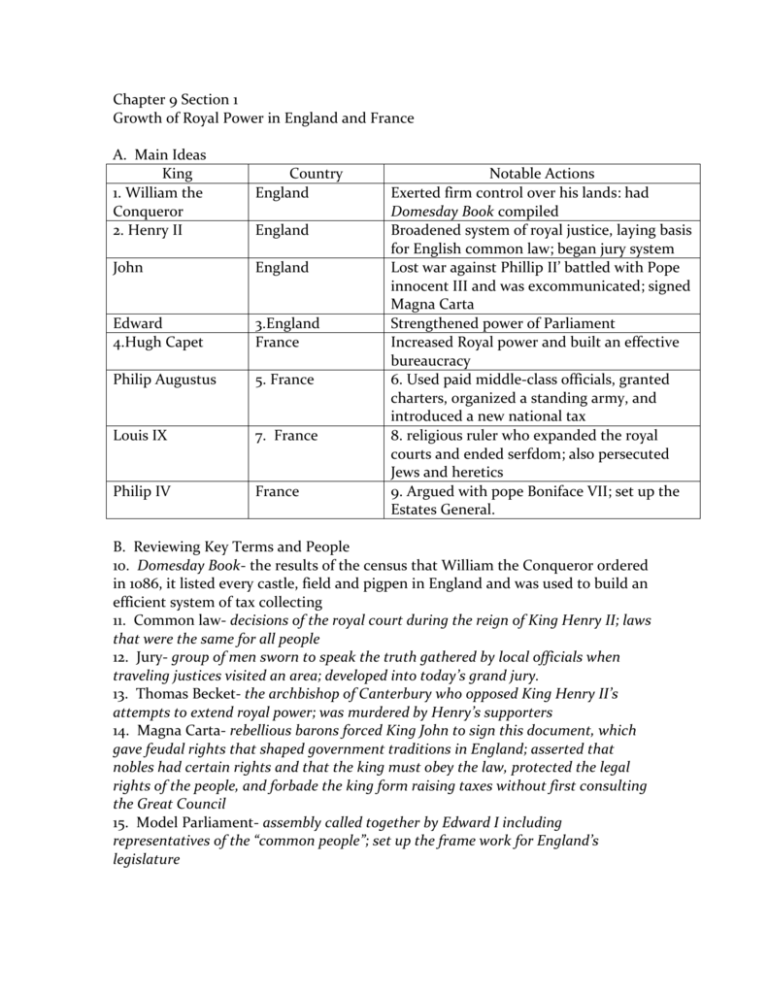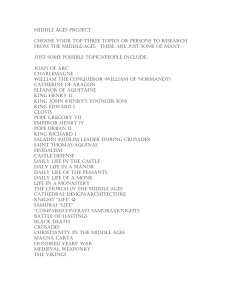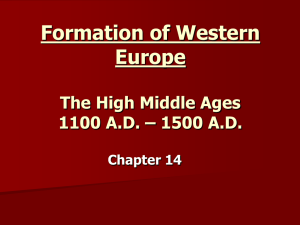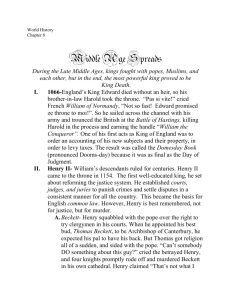Chapter 9 Section 1
advertisement

Chapter 9 Section 1 Growth of Royal Power in England and France A. Main Ideas King 1. William the Conqueror 2. Henry II Country England England John England Edward 4.Hugh Capet 3.England France Philip Augustus 5. France Louis IX 7. France Philip IV France Notable Actions Exerted firm control over his lands: had Domesday Book compiled Broadened system of royal justice, laying basis for English common law; began jury system Lost war against Phillip II’ battled with Pope innocent III and was excommunicated; signed Magna Carta Strengthened power of Parliament Increased Royal power and built an effective bureaucracy 6. Used paid middle-class officials, granted charters, organized a standing army, and introduced a new national tax 8. religious ruler who expanded the royal courts and ended serfdom; also persecuted Jews and heretics 9. Argued with pope Boniface VII; set up the Estates General. B. Reviewing Key Terms and People 10. Domesday Book- the results of the census that William the Conqueror ordered in 1086, it listed every castle, field and pigpen in England and was used to build an efficient system of tax collecting 11. Common law- decisions of the royal court during the reign of King Henry II; laws that were the same for all people 12. Jury- group of men sworn to speak the truth gathered by local officials when traveling justices visited an area; developed into today’s grand jury. 13. Thomas Becket- the archbishop of Canterbury who opposed King Henry II’s attempts to extend royal power; was murdered by Henry’s supporters 14. Magna Carta- rebellious barons forced King John to sign this document, which gave feudal rights that shaped government traditions in England; asserted that nobles had certain rights and that the king must obey the law, protected the legal rights of the people, and forbade the king form raising taxes without first consulting the Great Council 15. Model Parliament- assembly called together by Edward I including representatives of the “common people”; set up the frame work for England’s legislature 16. Saint Louis- King Louis IX of France, considered a model monarch; was made a saint within 30 years of his death 17. Estates General- governmental body set up in France by King Philip ub 1302; had representatives from France’s three classes Section 2- The Holy Roman Empire and the Church A. Main Ideas Otto I worked closely with the Church. He appointed bishops and abbots to top government jobs and 1.took an army south into Italy to help the pope put down a rebellion by Roman nobles. Otto’s successor took the title of 2._Holy Roman emperor__. These emperors claimed authority over much of central and Eastern Europe as well as parts of 3.___France and Italy________. A conflict arose between emperors and popes over 4.__who would control appointments of Church officials_____. Soon, Pope Gregory VII banned the practice of 5._lay investiture____. When Henry refused to comply, Gregory 6._excommunicated___ Henry in 1076. Finally, after years of struggling, the investiture conflict was ended by the 7._Concordat of Worms_______, which stated that 8.__the Church had the sole power to elect and invest bishops with spiritual authority with the emperor had the right to invest them with fiefs____. Then, the Holy Roman emperor Frederick II weakened Germany by becoming embroiled in 9.__Italy___’s affairs and spending little time in Germany. At the same time, Pope Gregory VII and other popes greatly increased papal power. In 1209, Pope Innocent III launched a brutal 10.__crusade__ against the Albigensians in southern France. B. Reviewing Key Terms and People 11. Gregory VII- pope who was determined to make the Church independent of secular rulers: excommunicated King Henry IV 12. Henry IV- Holy Roman emperor who fought against the Church on the issue of lay investiture 13. Concordat of Worms- treaty that ended the investiture struggle between the Church and Holy Roman emperors 14. Frederick II-Holy Roman emperor who sought power in Italy; weakened Germany by his inattention to its problems 15. Innocent III-pope who embodied the triumph to the Church; claimed supremacy over all other rulers and launched the Albigensian Crusade 16. Crusade- holy war sponsored by the Church 17. Albigensian Crusade- crusade launched by Pope Innocent III against the Albigensians in southern France who wanted to purify the Church Section 3- Europeans Look Outward Main Ideas 1. How did Muslims acquire and pass on a range of ideas and technologies? b. Through trade 2. Name three inventions of the Chinese under the Tang and Song dynasties b. Paper, printing, gunpowder, paper money 3. What was the state of civilizations in Africa and the Americas around 1050? b. In Africa, the Soninke people were building the great trading empire of Ghana. In the Americans, the Mays were building larger cities with towering temples. In Peru, Native Americans were building empires and creating great works of art 4. What was the purpose of the Crusades? b. The purpose of the Crusades, was to free the Holy Land from the control of non-Christians 5. How successful were the Crusades” What influence did the Crusades have eon trade and the Church? b. The Crusades failed in the conquest of the Holy Land. The Crusades increased trade and increased the power of feudal monarchs and the pope 6. What was the Inquisition? How was it related to the Reconquista? b. The Inquisition was the Church court set up by Isabella to try people accused of heresy. After the success of the Reconquista, Ferdinand and Isabella used this as one means to impose unity on the diverse peoples they now ruled. Reviewing Key terms and People-explain how the terms and/or names in each group are related. 7. Crusades, Council of Clermont-At the Council of Clermont, Pope Urban II called for a holy was against the Seljuk Turks, thus beginning the Crusades 8. Ferdinand and Isabella, Reconquista-Ferdinand and Isabella were the two monarchs who completed the Reconquista by winning Granada back from the Muslims Section 4- Learning, Literature and the Arts A. Main Ideas 1. During the High Middle Ages, the need for education expanded because the Church wanted better-educated clergy, royal rulers needed literate men for their bureaucracies and sons of wealthy townspeople could secure better jobs if there were educated 2. The exclusion of women from medieval universities affected their lives by depriving them of mental stimulation and excluding then from professions such as medicine, law, administration, the Church and teaching 3. Medieval literature was characterized by works written in the vernacular that captured the spirit of the times. 4. The stone cathedrals built during the Middle Ages were symbols of the people’s wealth and religious devotion 5. Besides their great beauty, cathedrals served to educate the literate masses by depicting biblical scenes in their sculpture and stained glass B. Reviewing Key terms and People __D_6. Italian poet who wrote the Divine Comedy __B_7. Brought together Christian faith and Greek philosophy _C__8. Every day language of ordinary people __G_9. Professional writer who wrote The City of Ladies _F__10. Epic work of literature from Spain __H_11. Wrote The Canterbury Tales __A_12. Support of thought that used reason to support Christian beliefs _E__13. System of Writing Numbers adopted in Europe during the middle ages a. scholasticism b. Thomas Aquinas c. Vernacular d. Dante e. Hindu-Arabic Numerals f. Poem of the Cid g. Christine de Pizan h. Chaucer Section 5- A time of Crisis A. Main Ideas- Rewrite each sentence to make it correct 1. The Black Death, which was caused by war and hunger, began in Spain and killed one in ten people all across Europe The Black Death, which was caused by fleas carried by rats, began in Italy and killed one in three people all across Europe. 2. People reacted to the plague calmly, seeking medical help and helping others. The plague brought terror and bewilderment, and thousands of Jews were killed after being blamed for causing the disease; normal life broke down completely 3. The plague helped Europe’s economy grow, and those who survived lived securely with a good income. The plague devastated Europe’s economy running production and causing high prices. Landowners converted farmlands to raising sheep, and those forced off the land sought work in towns but work was scarce. 4. The Church remained the only stable institution in plague-ravaged Europe. The Church was seriously weakened by the plague because it was unable to explain why it had happened. In addition, popular preachers challenged its power and teachings 5. The Hundred years’ War was fought between Italy and France, and neither side seemed capable of taking advantage of the new weaponry available. The Hundred Years’ War was fought between England and France. Both sides took advantage of new weaponry-first, the English with the longbow and then the French with the cannon. B. Reviewing Key Terms and People 6. Babylonian Captivity-period when the papal court was located in Avignon; refers to the time when the ancient Israelites were held captive in Babylon 7. John Wycliffe-Oxford professor who attacked Church corruption and translated the Bible into English so that people could read it for themselves 8. Jan Hus-lead the call for Church reforms in Bohemia; was burned at the stake for heresy 9. Joan of Arc- seventeen-year-old French peasant woman who, in the belief that she was inspired by God, led the French army to several victories; she was burned at the stake by the English The High Middle Ages-Map On the map above, label the places 1. 2. 3. 4. 5. 6. 7. Brittany—G Normandy—D Flanders-J Bordeaux-C England-A Agincourt, scene of an English Victory during the Hundred Year’s War- B Avignon, where the papal court was located following the dispute between Philip IV and Pope Boniface-E 8. Messina, Sicily, port where the bubonic plague entered Europe from Asia-H 9. Paris, home of one of the earliest European universities-F 10. Spain, where Christian forces gradually conquered Muslim rulers-I









